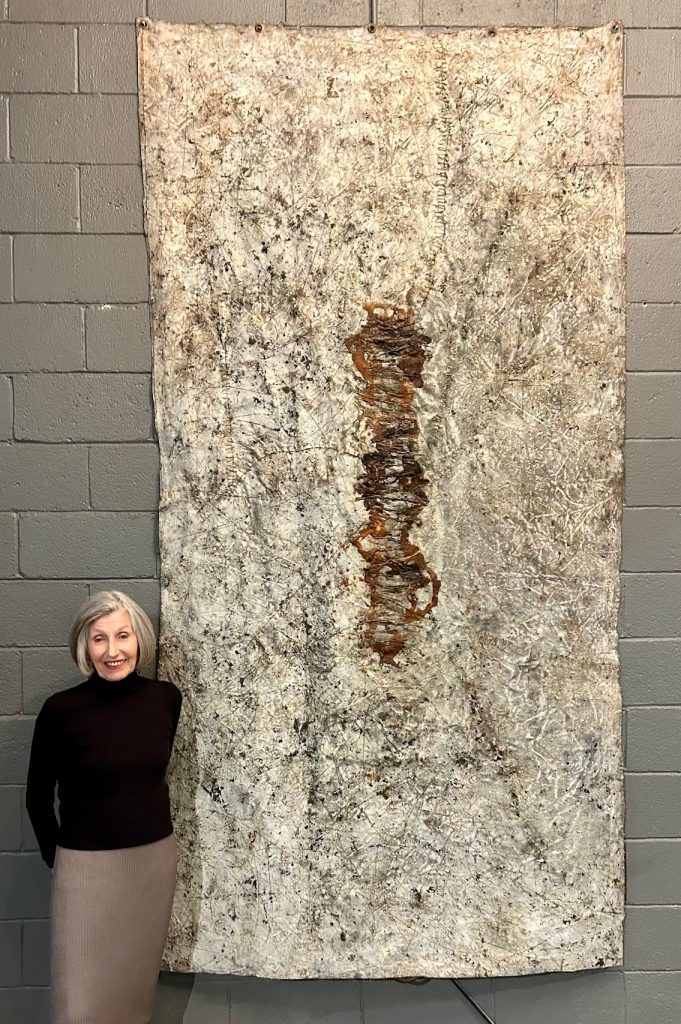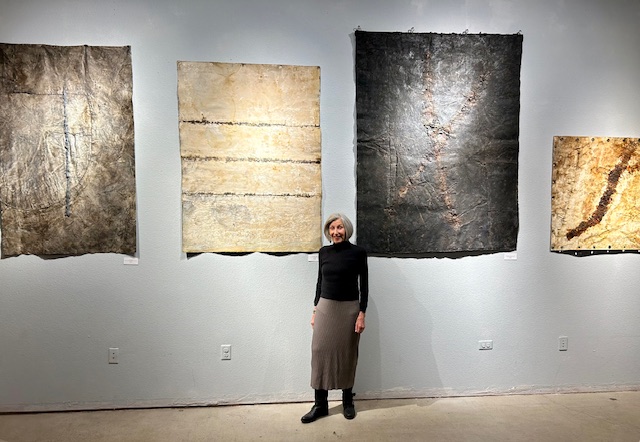A Solo Exhibition of My Large, Mixed Media Paintings in Albuquerque
 Earlier this year I had a second solo exhibition since moving to Albuquerque: Rose Marie Prins: Paintings, at ChatterAbq. I was thrilled to have finally found a space with walls high enough to accommodate my large mixed media paintings, most of them on unstretched canvas. These works are primarily from a series of paintings I started when I last lived in New Mexico. I continued working on the series in Virgina and then Florida.
Earlier this year I had a second solo exhibition since moving to Albuquerque: Rose Marie Prins: Paintings, at ChatterAbq. I was thrilled to have finally found a space with walls high enough to accommodate my large mixed media paintings, most of them on unstretched canvas. These works are primarily from a series of paintings I started when I last lived in New Mexico. I continued working on the series in Virgina and then Florida.
Below is a video made two years after I arrived in Florida. I’m including it here because some of the pieces in the ChatterAbq exhibition can be seen in the video. Also, I address the somewhat unconventional process involved in making these works.
Below are some of the reviews of these works.
“Prins’ mixed media works probe the notion of trauma and healing, destruction and rebirth. She slashes or burns her canvases, then repairs the wounds with wire stitches that branch off like waterways or coalesce surprisingly into crosses. She colors the canvases beneath the suture-like stitches with the bruised tinges of healing flesh, the blackened effect of a burn, the signals of pain that precede recovery, metaphors she naturally associates with life. Prins’ work voicelessly discloses a self portrait.”
–Curtia James, Gallery has brought six artists together for a “conversation,” Richmond Times-Dispatch
“Some of the strongest art currently showing in the Tampa Bay area is the work of South African-born … Rose Marie Prins… Though her visual language speaks to some of the most powerful sociopolitical issues of our time, she also ‘reveres process.’ Hers is cathartic, with surprisingly violent aesthetic impulses like gouging, burning or slashing. ‘Wounding’ the canvas is followed by ‘healing’ rituals with copper wire stitches… Yet the stitching seems more philosophically empowered than a feminine gesture.”
–Adrienne Golub, Biographical Touchstones, Weekly Planet
“Raymond Lawrence Gallery continues the international theme with South African émigré Rose Marie Prins, whose Joseph Beuys-like paintings form their dark crosses from cuts, scars and found metallic objects. One large, powerful unstretched canvas consists of nothing more than a broad field of artfully cultivated mold stains plus a few strokes of black paint. As in Prins’ moth sculptures of cast paper and animal bone, placement is everything.”
–Jerry Cullum, A Tula Smorgasbord: Botanicals, Birds, Abstraction, The Atlanta Journal-Constitution

You’ll also see in the video below several of my smaller mixed media pieces as well as a demonstration of the process involved in making them. The following is a review of these works:
“Rose Marie Prins’ small, mixed media, wall-hung works… were generated by over thirty years devoted to the practice and study of yoga… Prins’ focus on yoga, like all of her oeuvre, fuses the Duchampian found object legacy with a labor intensive process based on alchemical models of transformation… During an extended fabrication process it’s not unusual for the artist to weather her work outside. Less obvious, but not undetectable, is the artist’s practice of embedding her remarkable biography into art teeming with metaphor…
Her most successful works consisted of fabricated textured fields of background angst stabilized by small classically-centered and perfectly-placed found objects. In the outstanding Maya, a metal grid covers a central circle fastened by copper wire forming a cross. Small found objects intentionally trapped below a scratched and gouged surface resemble microscopic views of organic material, or topography transformed by a skin of impenetrable encaustic lava.
It’s impossible to ignore African art as another touchstone based on symmetry and coloration. Though solidified by encaustic, Prins’ surfaces are enlivened by shimmering flecks of gold, coagulated rivulets of ochres, and restrained copper.”
–Adrienne M. Golub, Art Papers